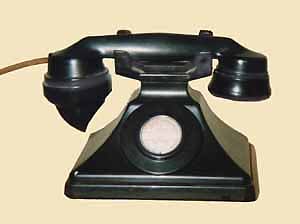 Type162 Type162
(Originally known as Tele 566A and CB)
With the introduction of commercial bakelite moulding, it became possible
to do away with the more expensive metal cased and wooden phones. In 1929
Siemens in Britain introduced a new style of phone in which the whole case,
cradle and handset were moulded from bakelite. The new phone was called the
Neophone
and the British Post Office adopted a modified version of it as a standard
model. In 1933 it was introduced in Australia as the Tele 162, after two years
testing. It became the standard desk phone.
It had no bell or coil, so it was associated with a separate ringer box that
held these parts. Since this was the same box that was used for candlestick
phones, it made the 162 the logical replacement for these as they wore out.
A bolt-on bellset was designed later to be attached under the phone by a short
external cable that was subject to damage. Another problem was that the cradle
was quite vulnerable to breakage. An extra rental was charged for the new handset
phones. This was only discontinued in 1950. For a magneto version, a separate
generator box was added as for the Type 36.
The 162 could also be wall mounted on a simple bracket. There was a British
wall equivalent but it does not appear to have been used by the PMG in Australia
in great numbers. The phone was available in black, red, green , ivory, and
a mottled brown "walnut" finish that is rare and was not issued in
Australia. All but the black proved prone to fading in Australia. An optional
note tray was fitted into the base of some models. Extra rent was charged for
the note tray and optional colours. Some British phones could also be ordered
in a custom painted finish. One uncommon model is known, cast in aluminium and
painted black.
 The use of a separate ringer box was acceptable when upgrading an existing installation,
but the extra labour cost was a concern for new installations. A matching bakelite
ringer was designed that mounted under the phone, and made the 162 a completely
self-contained unit. It connected to the phone by an external cable at the rear.
It could be detached to make the phone portable if needed. This was numbered
Type 566.
The use of a separate ringer box was acceptable when upgrading an existing installation,
but the extra labour cost was a concern for new installations. A matching bakelite
ringer was designed that mounted under the phone, and made the 162 a completely
self-contained unit. It connected to the phone by an external cable at the rear.
It could be detached to make the phone portable if needed. This was numbered
Type 566.
In Australia, the phones were made by Standard Telephones & Cables (STC),
Amalgamated Wireless Australasia (AWA), and some probably by the Telephone
Manufacturing Company (TMC) using imported parts.
 Left:
162CB circuit Left:
162CB circuit
 To
Tele 232 To
Tele 232
 To
QuickFind To
QuickFind
 If you have reached this page through a Search Engine, this will take you to the front page of the website If you have reached this page through a Search Engine, this will take you to the front page of the website
|